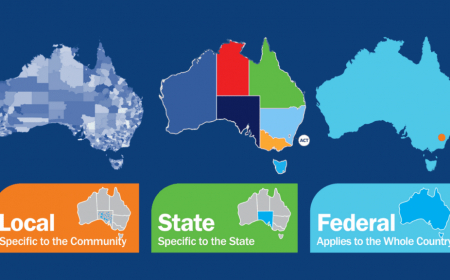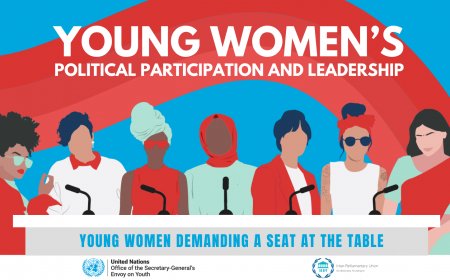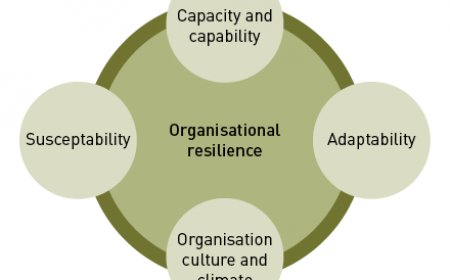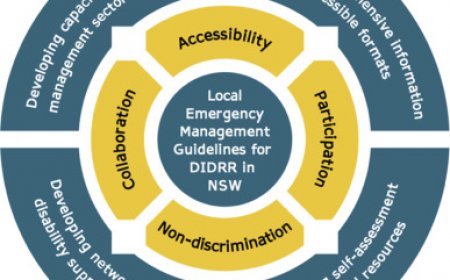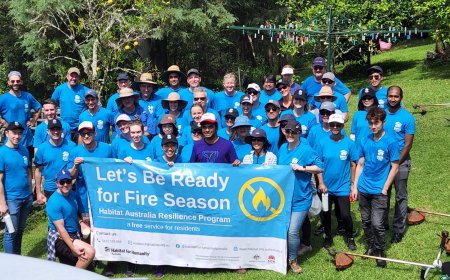Australia Civic Engagement Guide for 2025
A comprehensive guide to civic engagement in Australia for 2025, covering electoral processes, community activism, digital advocacy, and accessibility. Learn how to participate effectively and strengthen democracy.
Civic engagement is the cornerstone of a thriving democracy, and in Australia, it plays an indispensable role in shaping policies, fostering community cohesion, and ensuring that every voice is heard. As we look ahead to 2025, the need for active participation in civic processes has never been more critical. From voting in elections to volunteering in local initiatives, Australians have a unique opportunity to contribute to the nation's progress. This guide serves as a comprehensive resource for understanding and enhancing civic engagement across the country.
In this article, we delve into the multifaceted dimensions of civic engagement, offering actionable insights and strategies tailored specifically for the Australian context. Whether you're a seasoned advocate or new to the concept, this guide will equip you with the knowledge and tools necessary to make a meaningful impact. We explore the importance of civic engagement , outline various avenues for involvement, and provide practical steps to foster greater participation.
By addressing key topics such as electoral processes , community activism , and digital advocacy , we aim to empower individuals and organizations to take proactive steps toward a more inclusive and participatory society. Our goal is to ensure that by 2025, civic engagement becomes not just a responsibility but a shared commitment among all Australians.
The Importance of Civic Engagement in Australia
Civic engagement is more than just a democratic obligation; it is a vital mechanism through which citizens can influence governance, promote social equity, and drive sustainable development. In Australia, civic engagement serves as a bridge between the government and its people, enabling the exchange of ideas, concerns, and aspirations. The significance of this interaction cannot be overstated, as it directly impacts the quality of life, policy outcomes, and the overall health of the nation’s democracy.
One of the primary reasons civic engagement is so crucial is its role in ensuring accountability . When citizens actively participate in civic processes—whether through voting, attending town hall meetings, or engaging in public consultations—they hold elected officials accountable for their actions. This accountability fosters transparency and trust, essential elements for a functioning democracy. Moreover, civic engagement empowers marginalized groups, giving them a platform to voice their concerns and advocate for systemic change.
Another critical aspect of civic engagement is its ability to drive innovation and progress . By involving diverse perspectives in decision-making, governments and organizations can craft policies that are more inclusive and effective. For instance, community-led initiatives often identify grassroots issues that might otherwise go unnoticed, leading to innovative solutions tailored to local needs. This collaborative approach not only strengthens communities but also enhances the resilience of the nation as a whole.
Furthermore, civic engagement fosters a sense of belonging and shared responsibility . When individuals actively contribute to their communities, they develop a deeper connection to the places they live and the people they interact with. This sense of belonging is particularly important in multicultural societies like Australia, where fostering unity amidst diversity is a constant challenge. Through civic participation, Australians can celebrate their differences while working together toward common goals.
Finally, civic engagement is a powerful tool for educating and empowering citizens . It encourages individuals to stay informed about current affairs, understand their rights and responsibilities, and develop critical thinking skills. This education is vital for maintaining a well-functioning democracy, as it ensures that citizens are equipped to make informed decisions and resist misinformation. By prioritizing civic engagement, Australia can build a more knowledgeable and resilient populace capable of navigating the complexities of the modern world.
Understanding Electoral Processes in Australia
Electoral processes form the backbone of civic engagement in any democracy, and Australia is no exception. Understanding how these processes work is essential for citizens who wish to participate meaningfully in shaping the nation's future. Australia employs a unique system of voting that combines compulsory participation with preferential voting methods, ensuring that elections are both inclusive and representative.
Compulsory Voting: A Pillar of Australian Democracy
One of the most distinctive features of Australia's electoral system is its requirement for compulsory voting . Enforced since 1924, this mandate ensures that all eligible citizens aged 18 and above must participate in federal, state, and local elections. Failure to vote without a valid reason can result in fines, making Australia one of the few countries globally where voting is not optional. This system has several advantages, including higher voter turnout rates, reduced political polarization, and increased legitimacy of elected representatives.
Compulsory voting ensures that election outcomes reflect the will of the majority, rather than being skewed by the preferences of a small, motivated minority. It also minimizes the influence of socioeconomic factors on voter participation, as individuals from all walks of life are equally obligated to engage in the electoral process. However, critics argue that compulsory voting infringes on personal freedoms and may lead to disengaged or uninformed voting. Despite these concerns, the system has proven effective in fostering widespread civic participation.
Preferential Voting: Ensuring Fair Representation
Australia utilizes a preferential voting system for most elections, which allows voters to rank candidates in order of preference. This method is particularly prominent in federal House of Representatives elections and some state-level contests. Under preferential voting, if no candidate secures an outright majority (more than 50% of the vote), the candidate with the fewest votes is eliminated, and their preferences are redistributed to remaining candidates. This process continues until one candidate achieves a majority.
Preferential voting offers several benefits over first-past-the-post systems. It reduces the likelihood of "wasted votes" and encourages voters to support smaller parties or independent candidates without fear of inadvertently aiding their least preferred option. Additionally, it promotes coalition-building and consensus-driven politics, as candidates must appeal to a broader spectrum of voters to secure second and third preferences. This system aligns with Australia's commitment to fairness and inclusivity, ensuring that diverse voices are represented in government.
The Role of the Australian Electoral Commission (AEC)
The Australian Electoral Commission (AEC) plays a pivotal role in managing and overseeing electoral processes across the country. Established as an independent statutory authority, the AEC is responsible for conducting federal elections, referendums, and redistributions of electoral boundaries. Its duties include maintaining the electoral roll, providing educational resources to voters, and ensuring compliance with electoral laws.
The AEC's efforts extend beyond administrative tasks; it actively works to enhance voter accessibility and engagement. For example, the commission provides multilingual resources to assist non-English-speaking citizens, facilitates mobile polling stations for remote communities, and implements measures to accommodate voters with disabilities. These initiatives underscore the AEC's commitment to creating an inclusive and equitable electoral environment.
Challenges and Opportunities in Modern Elections
While Australia's electoral processes are robust, they are not without challenges. Issues such as voter apathy , misinformation , and cybersecurity threats pose significant risks to the integrity of elections. Addressing these challenges requires a multi-faceted approach, including enhanced voter education programs, stricter regulations on political advertising, and investment in secure digital infrastructure.
At the same time, advancements in technology present opportunities to modernize electoral processes. Online voter registration, electronic voting systems, and real-time data analytics could streamline operations and improve accessibility. However, these innovations must be implemented cautiously to safeguard against potential vulnerabilities and ensure that traditional principles of fairness and transparency are upheld.
By understanding and actively participating in Australia's electoral processes, citizens can contribute to a more vibrant and resilient democracy. Whether through casting informed votes, volunteering as polling officials, or advocating for electoral reforms, every individual has a role to play in shaping the nation's future.
Community Activism: Grassroots Movements Shaping Australia
Community activism stands as a testament to the power of collective action in driving societal change. Across Australia, grassroots movements have emerged as dynamic forces, addressing pressing issues ranging from climate change to social justice. These movements are characterized by their bottom-up approach, where ordinary citizens unite to advocate for causes they are passionate about, often challenging established norms and policies.
The Rise of Environmental Advocacy
One of the most prominent areas of community activism in Australia is environmental advocacy. With the country facing significant ecological challenges, such as deforestation, biodiversity loss, and the impacts of climate change, activists have mobilized to demand urgent action. Groups like the Australian Conservation Foundation and Extinction Rebellion have organized protests, campaigns, and educational initiatives to raise awareness and pressure policymakers.
These movements leverage a variety of strategies to amplify their message. Social media platforms serve as powerful tools for organizing events, sharing information, and garnering public support. Additionally, activists collaborate with scientists, indigenous leaders, and other stakeholders to craft evidence-based solutions that prioritize sustainability and equity. The success of campaigns like the fight against the Adani coal mine highlights the effectiveness of grassroots efforts in influencing corporate and governmental decisions.
Social Justice and Equity Initiatives
Beyond environmental concerns, community activism in Australia also addresses social justice issues, striving to create a more equitable society. Movements advocating for Indigenous rights , LGBTQ+ equality , and refugee support have gained momentum, driven by passionate individuals and organizations committed to systemic change.
For instance, the Uluru Statement from the Heart represents a landmark initiative calling for constitutional recognition and a Voice to Parliament for Indigenous Australians. This movement underscores the importance of listening to and elevating marginalized voices, ensuring that policies reflect the needs and aspirations of all citizens. Similarly, LGBTQ+ advocacy groups continue to push for reforms in areas such as marriage equality, anti-discrimination laws, and healthcare access, celebrating victories while addressing ongoing challenges.
Refugee advocacy is another critical area where community activism has made significant strides. Organizations like the Asylum Seeker Resource Centre provide essential services and campaign for humane treatment and fair processing of asylum claims. Through rallies, petitions, and direct support, activists highlight the human stories behind immigration policies, fostering empathy and urging legislative reform.
Local Community Building and Volunteerism
At a more localized level, community activism manifests through volunteerism and neighborhood initiatives aimed at strengthening social bonds and improving quality of life. From community gardens and clean-up drives to local festivals and support networks, these efforts foster a sense of belonging and shared responsibility.
Volunteer organizations play a crucial role in this landscape, offering platforms for individuals to contribute their time and skills toward meaningful causes. Programs focused on youth mentorship, elder care, and disaster relief exemplify the diverse ways in which communities come together to address specific needs. Such initiatives not only tackle immediate challenges but also build long-term resilience and solidarity.
Challenges and Opportunities for Activists
Despite their successes, grassroots movements face numerous challenges, including limited resources, legal restrictions, and resistance from vested interests. Navigating these obstacles requires strategic planning, coalition-building, and adaptability. Activists must also contend with burnout and fatigue, underscoring the importance of self-care and sustainable practices within movements.
However, opportunities abound for those willing to innovate and persevere. Advances in technology offer new avenues for engagement, fundraising, and advocacy. Collaborations with academic institutions, businesses, and international partners can expand reach and impact. Moreover, the growing recognition of the value of community-led solutions provides fertile ground for continued growth and influence.
By embracing these opportunities and addressing challenges head-on, community activists in Australia can continue to shape the nation's trajectory, championing causes that resonate deeply with the values and aspirations of its people.
Digital Advocacy: Harnessing Technology for Civic Participation
In the digital age, technology has revolutionized the way citizens engage with civic processes, amplifying voices and expanding opportunities for participation. Digital advocacy leverages online platforms, tools, and strategies to promote causes, mobilize supporters, and influence decision-makers. In Australia, digital advocacy has become an integral component of civic engagement, enabling individuals and organizations to connect, collaborate, and effect change on a scale previously unimaginable.
The Power of Social Media in Advocacy
Social media platforms such as Facebook, Twitter, Instagram, and LinkedIn have transformed the landscape of civic engagement, providing accessible and far-reaching channels for communication. These platforms allow advocates to share information, organize campaigns, and engage with a global audience in real-time. For instance, hashtags like #ClimateActionNow and #CloseTheGap have galvanized millions of Australians around pressing issues, fostering a sense of urgency and collective action.
One of the key strengths of social media is its ability to democratize advocacy . Unlike traditional media, which often requires significant resources and gatekeeping, social media enables anyone with internet access to participate in conversations, share their perspectives, and build communities around shared values. This inclusivity has empowered grassroots movements, allowing them to bypass traditional barriers and achieve remarkable visibility and impact.
Moreover, social media facilitates real-time feedback and dialogue between advocates and their audiences. Polls, live streams, and comment sections provide immediate insights into public sentiment, enabling campaigners to refine their messaging and strategies dynamically. This interactivity not only enhances engagement but also builds trust and credibility, as audiences perceive advocates as responsive and authentic.
Crowdsourcing and Crowdfunding for Civic Projects
Digital platforms have also enabled innovative approaches to funding and resource mobilization through crowdsourcing and crowdfunding . These methods allow individuals and organizations to pool resources, expertise, and ideas to support civic initiatives. Platforms like GoFundMe, Pozible, and Kickstarter have been instrumental in financing projects ranging from community art installations to environmental conservation efforts.
Crowdsourcing extends beyond financial contributions, encompassing the collection of data, opinions, and creative input. For example, citizen science projects like the Atlas of Living Australia invite participants to contribute observations and insights, enriching datasets used for research and policy-making. Similarly, open-source software initiatives enable developers worldwide to collaborate on tools that enhance civic engagement, such as apps for tracking legislation or analyzing election results.
By harnessing the collective power of crowds, digital advocacy democratizes access to resources and expertise, leveling the playing field for underfunded or marginalized groups. This inclusivity fosters innovation and ensures that diverse voices are represented in civic endeavors.
E-Petitions and Online Campaigning Tools
E-petitions and online campaigning tools represent another facet of digital advocacy, streamlining the process of gathering support and influencing policymakers. Websites like Change.org and GetUp! enable users to create and sign petitions on a wide array of issues, from environmental protection to social justice reforms. These platforms simplify the logistics of petitioning, allowing advocates to focus on crafting compelling narratives and mobilizing supporters.
Online campaigning tools complement e-petitions by providing additional functionalities, such as email marketing, event management, and analytics. Organizations can use these tools to segment audiences, personalize communications, and measure campaign performance. For instance, sophisticated CRM systems allow campaigners to track supporter interactions, optimize outreach strategies, and maximize engagement.
The integration of e-petitions and campaigning tools creates a seamless ecosystem for digital advocacy, empowering individuals and organizations to launch coordinated, data-driven campaigns. This synergy enhances efficiency and effectiveness, increasing the likelihood of achieving desired outcomes.
Challenges and Ethical Considerations in Digital Advocacy
While digital advocacy offers numerous benefits, it also presents challenges and ethical considerations that must be addressed. Issues such as misinformation , data privacy , and algorithmic bias can undermine the credibility and impact of online campaigns. Misinformation spreads rapidly on social media, potentially distorting public discourse and eroding trust in advocacy efforts.
To combat misinformation, advocates must prioritize accuracy and transparency, verifying sources and clearly labeling content. Implementing robust fact-checking mechanisms and collaborating with reputable organizations can bolster credibility and mitigate risks. Additionally, respecting data privacy is paramount, as mishandling personal information can alienate supporters and expose organizations to legal liabilities.
Algorithmic bias poses another challenge, as platform algorithms may inadvertently favor certain types of content or suppress marginalized voices. Advocates must remain vigilant, monitoring algorithmic trends and adapting strategies accordingly. Engaging with platform providers and advocating for algorithmic transparency can help address these biases and ensure equitable representation.
The Future of Digital Advocacy in Australia
Looking ahead, the future of digital advocacy in Australia holds immense promise, driven by technological advancements and evolving societal needs. Emerging technologies such as artificial intelligence, blockchain, and virtual reality offer exciting possibilities for enhancing civic engagement. AI-powered chatbots can provide personalized support and guidance, while blockchain ensures secure and transparent transactions. Virtual reality experiences can immerse users in immersive storytelling, fostering empathy and understanding.
As digital advocacy continues to evolve, it is imperative for practitioners to embrace innovation while upholding ethical standards. By leveraging technology responsibly and inclusively, digital advocates can amplify their impact, inspire meaningful change, and strengthen Australia's democratic fabric.
Accessibility: Removing Barriers to Civic Participation
Ensuring accessibility in civic engagement is a fundamental step toward fostering an inclusive democracy. Accessibility refers to the removal of barriers that prevent individuals from fully participating in civic processes, whether due to physical, cognitive, socioeconomic, or cultural limitations. In Australia, addressing accessibility challenges is not only a matter of equity but also a legal and moral obligation enshrined in frameworks such as the Disability Discrimination Act 1992 and the United Nations Convention on the Rights of Persons with Disabilities .
Physical Accessibility in Electoral Processes
Physical accessibility is a critical component of civic engagement, particularly in the context of voting and public consultations. For individuals with mobility impairments, accessing polling stations or attending town hall meetings can present significant challenges. To address this, the Australian Electoral Commission (AEC) has implemented measures to ensure that polling places are wheelchair-accessible, provide ramps, and offer alternative voting options such as postal or telephone voting.
Additionally, advancements in technology have introduced innovations like mobile polling stations and electronic voting systems , which bring electoral processes closer to citizens who may face difficulties traveling to traditional polling locations. These initiatives are complemented by provisions for assistance at polling booths , where trained staff or volunteers help voters complete ballots if required. While progress has been made, there remains room for improvement, particularly in rural and remote areas where infrastructure may be limited.
Cognitive and Sensory Accessibility
Beyond physical barriers, cognitive and sensory impairments also necessitate tailored accommodations to ensure equitable participation. For individuals with visual impairments, the provision of braille ballots , audio guides , and screen reader-compatible websites is essential. Similarly, those with hearing impairments benefit from sign language interpreters at public forums, captioned videos, and text-based communication options.
Cognitive accessibility focuses on simplifying complex information to make it understandable for individuals with intellectual disabilities or low literacy levels. This includes using plain language in official documents, creating visual aids, and offering step-by-step guidance for completing forms or registering to vote. Educational campaigns designed to inform citizens about their rights and responsibilities must also adopt inclusive formats, ensuring that no one is excluded due to comprehension barriers.
Socioeconomic and Cultural Accessibility
Socioeconomic and cultural factors can significantly influence an individual's ability to engage civically. Financial constraints may limit access to transportation, internet connectivity, or even basic identification documents required for voting. To mitigate these barriers, governments and organizations can implement policies such as free public transport on election days , subsidized internet programs , and waived fees for ID issuance .
Cultural accessibility involves recognizing and respecting the diverse backgrounds of Australia’s population. Indigenous communities, migrants, and refugees often face unique challenges in navigating civic processes due to language barriers, unfamiliarity with systems, or historical disenfranchisement. Providing multilingual resources , culturally sensitive outreach programs , and community liaison officers can bridge these gaps and foster trust. Furthermore, incorporating Indigenous knowledge systems and leadership into decision-making processes ensures that policies reflect the needs of First Nations peoples.
Digital Accessibility: Bridging the Divide
As civic engagement increasingly shifts online, ensuring digital accessibility is paramount. Websites, apps, and digital platforms must comply with standards such as the Web Content Accessibility Guidelines (WCAG) to accommodate users with disabilities. Features like adjustable font sizes, high-contrast modes, keyboard navigation, and alt text for images are examples of design elements that enhance usability.
Efforts to improve digital literacy are equally important, especially for older adults, low-income households, and rural residents who may lack familiarity with technology. Offering free workshops, tutorials, and helplines can empower these groups to navigate digital civic tools confidently. Public libraries and community centers can serve as hubs for accessing computers and receiving assistance, further reducing the digital divide.
Policy Recommendations for Enhanced Accessibility
To achieve universal accessibility in civic engagement, policymakers must adopt a holistic approach that integrates multiple dimensions of inclusion. Key recommendations include:
- Conducting regular audits of polling stations, websites, and materials to identify and rectify accessibility gaps.
- Allocating sufficient funding for adaptive technologies and training programs.
- Partnering with disability advocacy groups to co-design solutions that meet user needs effectively.
- Establishing clear guidelines and accountability mechanisms to enforce accessibility standards.
- Promoting awareness campaigns to educate both citizens and service providers about the importance of accessibility.
By prioritizing accessibility, Australia can create a civic environment where every individual has the opportunity to contribute meaningfully, regardless of their circumstances. This commitment not only strengthens democracy but also reflects the nation’s core values of fairness, equality, and respect for diversity.
How to Get Involved in Civic Engagement in Australia
Participating in civic engagement is a powerful way to shape the future of Australia, and there are numerous avenues available for individuals to get involved. Whether you're interested in formal electoral processes, grassroots activism, or digital advocacy, the following steps provide a roadmap to becoming an active and impactful participant in civic life.
Step 1: Register to Vote
The foundation of civic engagement begins with exercising your right to vote. In Australia, voting is compulsory for all citizens aged 18 and above, making it essential to ensure your enrollment is up-to-date. Visit the Australian Electoral Commission (AEC) website to check your registration status or enroll if you haven’t already. The process is straightforward and can be completed online, ensuring that you’re ready to cast your ballot in upcoming elections.
Once registered, familiarize yourself with the electoral system, including how preferential voting works and the roles of different levels of government. Understanding these mechanics will empower you to make informed decisions when selecting candidates and participating in referendums.
Step 2: Educate Yourself on Key Issues
Staying informed is a cornerstone of effective civic engagement. Regularly follow reputable news outlets, subscribe to newsletters from advocacy organizations, and attend public forums to deepen your understanding of current affairs. Topics such as climate change, healthcare, education, and social justice are often at the forefront of national discussions, and having a well-rounded perspective will enhance your ability to contribute meaningfully.
Consider joining local community groups or online forums dedicated to specific causes. These platforms provide opportunities to learn from others, ask questions, and engage in constructive dialogue. Many organizations also offer educational resources, workshops, and webinars to help you stay updated on emerging issues and policy developments.
Step 3: Volunteer Your Time and Skills
Volunteering is one of the most direct ways to make a tangible impact in your community. Whether it’s assisting at a local food bank, mentoring students, or participating in environmental clean-up drives, your contributions can address immediate needs while fostering long-term resilience. Volunteering also connects you with like-minded individuals, creating networks that amplify collective efforts.
If you’re passionate about electoral processes, consider volunteering as a polling official during elections. The AEC recruits thousands of temporary staff to manage polling stations, count votes, and assist voters. This role not only supports the democratic process but also provides valuable insights into how elections are conducted.
Step 4: Advocate for Change Through Digital Platforms
In today’s interconnected world, digital advocacy offers unparalleled opportunities to influence public opinion and policy. Start by identifying causes you care about and researching organizations or campaigns aligned with your values. Platforms like Change.org and GetUp! allow you to sign petitions, share content, and mobilize others around shared goals.
Social media is another powerful tool for advocacy. Create posts, join discussions, and use relevant hashtags to raise awareness about issues affecting your community. Remember to verify information before sharing and prioritize respectful, evidence-based communication to maintain credibility.
Step 5: Engage in Local Government and Decision-Making
Local government plays a crucial role in shaping everyday life, from urban planning to public safety. Attend council meetings, submit feedback on proposed projects, and participate in consultations to ensure your voice is heard. Many councils also offer opportunities to join advisory committees or apply for grants to fund community initiatives.
If you’re interested in taking a more active role, consider running for local office or supporting candidates who align with your vision for the community. Grassroots campaigns often rely on volunteers for canvassing, fundraising, and organizing events, providing ample opportunities to contribute.
Step 6: Support Indigenous-Led Initiatives
Recognizing and uplifting Indigenous voices is vital for fostering reconciliation and equity in Australia. Engage with organizations led by First Nations peoples, such as the National Congress of Australia’s First Peoples , and support initiatives that promote self-determination, cultural preservation, and economic empowerment. Participating in events like NAIDOC Week or learning about Indigenous history and traditions can deepen your understanding and commitment to allyship.
Step 7: Leverage Professional Expertise
Your professional skills can be a valuable asset in advancing civic causes. Lawyers, accountants, marketers, and IT professionals, among others, can offer pro bono services to nonprofit organizations or community groups. For example, developing a website, designing promotional materials, or providing legal advice can significantly enhance the capacity of these entities to achieve their missions.
Step 8: Collaborate Across Generations
Intergenerational collaboration enriches civic engagement by combining the wisdom of older generations with the energy and innovation of younger ones. Mentor young activists, involve seniors in technology training, and create spaces where diverse age groups can exchange ideas and work together toward common objectives.
Step 9: Measure and Reflect on Your Impact
Finally, regularly assess the outcomes of your efforts and reflect on how you can improve. Keep track of milestones achieved, lessons learned, and areas for growth. Sharing your experiences with others can inspire them to take action, creating a ripple effect of positive change.
By following these steps, you can embark on a fulfilling journey of civic engagement that not only benefits your community but also strengthens Australia’s democratic foundations.
Conclusion: Strengthening Civic Engagement for a Brighter Future
As we approach 2025, the imperative for robust civic engagement in Australia has never been clearer. The collective efforts of individuals, communities, and organizations form the bedrock of a thriving democracy, ensuring that governance remains transparent, inclusive, and responsive to the needs of all citizens. Throughout this guide, we have explored the multifaceted dimensions of civic engagement, from understanding electoral processes and participating in grassroots activism to leveraging digital platforms and addressing accessibility challenges. Each of these components plays a vital role in fostering a culture of active citizenship and shared responsibility.
The journey toward enhanced civic engagement requires sustained commitment and collaboration. By educating ourselves, volunteering our time, advocating for systemic change, and supporting marginalized voices, we can collectively shape policies and initiatives that reflect the diversity and aspirations of the Australian populace. Moreover, embracing innovation and technology will continue to expand opportunities for participation, making civic processes more accessible and impactful.
Ultimately, civic engagement is not merely a duty but a privilege—a chance to contribute to the betterment of society and leave a lasting legacy for future generations. As Australians, we have the tools, resources, and determination to build a more equitable, sustainable, and resilient nation. Let us seize this moment to strengthen our democratic institutions, celebrate our differences, and work together toward a brighter, more inclusive future.
10 Frequently Asked Questions (FAQs) About Civic Engagement in Australia
1. What is civic engagement?
Civic engagement refers to the active participation of individuals in activities that contribute to the well-being of their communities and the functioning of democracy. This includes voting, volunteering, advocacy, and involvement in local decision-making processes.
2. Why is voting compulsory in Australia?
Voting is compulsory in Australia to ensure high voter turnout and reduce the influence of socioeconomic factors on participation. It promotes accountability and ensures that election outcomes reflect the will of the majority.
3. How does preferential voting work?
Preferential voting allows voters to rank candidates in order of preference. If no candidate secures a majority, the candidate with the fewest votes is eliminated, and their preferences are redistributed until one candidate achieves a majority.
4. What role does the Australian Electoral Commission (AEC) play?
The AEC manages federal elections, maintains the electoral roll, educates voters, and ensures compliance with electoral laws. It also implements measures to enhance accessibility and inclusivity in the voting process.
5. How can I get involved in community activism?
You can join local advocacy groups, participate in protests or campaigns, volunteer for causes you care about, or collaborate with organizations working on issues such as environmental protection, social justice, or Indigenous rights.
6. What are some examples of successful grassroots movements in Australia?
Examples include campaigns against the Adani coal mine, the Uluru Statement from the Heart advocating for Indigenous constitutional recognition, and LGBTQ+ equality initiatives like marriage reform.
7. How can technology enhance civic engagement?
Technology enables digital advocacy through social media, e-petitions, crowdfunding, and crowdsourcing. It also improves accessibility via mobile polling stations, electronic voting systems, and accessible online platforms.
8. What are the main barriers to accessibility in civic engagement?
Barriers include physical limitations (e.g., inaccessible polling stations), cognitive or sensory impairments, socioeconomic constraints, cultural differences, and the digital divide.
9. How can I advocate for policy changes?
Engage with elected representatives, sign petitions, participate in consultations, use social media to raise awareness, and collaborate with advocacy organizations to amplify your message.
10. What steps can I take to encourage others to participate in civic processes?
Educate others about the importance of civic engagement, share resources, organize workshops, lead by example, and create inclusive spaces for discussion and collaboration.
What's Your Reaction?
 Like
0
Like
0
 Dislike
0
Dislike
0
 Love
0
Love
0
 Funny
0
Funny
0
 Angry
0
Angry
0
 Sad
0
Sad
0
 Wow
0
Wow
0



